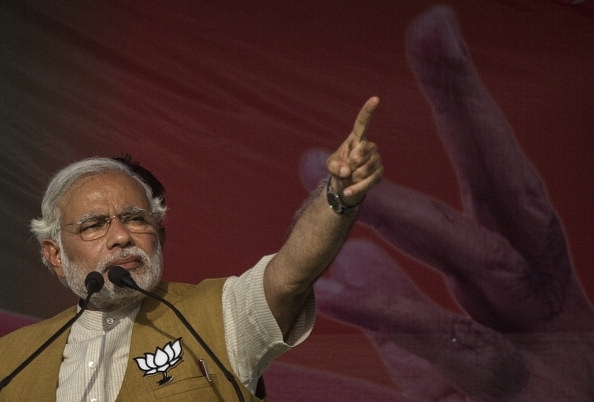Politics
Not A Wave. Not A Landslide. It’s A Tsunamo. And It’s Not Built On Class.
- The vikas fever that captured the imagination of a large cross-section of the nation, led by Uttar Pradesh in 2014, has come full circle.

Prime Minister Narendra Modi gestures while speaking to the crowd at a rally in Sidhuali, near Lucknow, India. (Kevin Frayer/Getty Images)
Perhaps we just witnessed the most game-changing electoral result since independence. At least, the most important one since liberalisation for the fortunes of over a billion people.
The record-shattering electoral victory of Prime Minister Narendra Modi-led Bharatiya Janata Party (BJP) throws prevalent electoral dynamics and punditry to the wind and arguably sets a new normal in the politics of Uttar Pradesh. Those who sought to analyse this election through the old lens of mandal-kamandal have had to eat humble samosa.
The vikas fever that captured the imagination of a large cross-section of the nation, led by Uttar Pradesh in 2014, has come full circle.
While actual vote shares of the parties among various cross-sections of Uttar Pradesh are yet to come out, one thing is clear – such a number cannot be achieved without support from across the caste spectrum. There are others who have observed that Modi has successfully changed Uttar Pradesh politics from one of caste to one of class. That is only partly true. He may well have made people go beyond caste but not towards class, rather towards aspiration in general and towards economic mobility.
This isn’t about pitting one class against another but about making one class aspire for the one above it. Aspiration is being awakened in the middle class and the neo-middle class to scale the economic ladder towards more self-reliance and upward economic mobility. The stress is clearly on enablement to this idea rather than exacerbating class fault lines.
In fact, there is evidence. The Prime Minister has successfully appealed to the upper class and the middle class to give up their LPG subsidy so that the same can be routed to the poor. And in a stunning show of cooperation, those classes, approximately more than a crore, happily gave it up. So, this falls straight into Modi’s pet theme of Jan Bhagidari – a partnership between the government and the people.
Another thing going for it across classes was, it was seen as something that did not favour any group over another. Among the middle class, it was seen as necessary trouble that everyone should be willing to take. One even heard of how when the poor themselves were willing to stay with it, the digitally empowered middle-class shouldn’t crib.
While Modi has reiterated that his government is mainly for the poor and disadvantaged, he has also said that it is they who need a functioning government the most. This is something that sections of the middle class would also be willing to concede rather than contest, as indicated by the voluntary giving up of LPG subsidy.
Even in the south, among people in the suave surroundings of technology firms, one often heard that it was Uttar Pradesh that needed Modi the most. Only with any improvement in the state’s vast landscape could India itself grow sustainably. It is clear that many are willing to invest in Modi to better the lives of their less-fortunate countrymen, and this is the antithesis of a class divide.
When one speaks of class trumping caste considerations, one automatically assumes an ‘other’ exists. But as it has repeatedly been seen, despite his pro-poor rhetoric, the Prime Minister is seen by every class as its own, except the establishment elite.
The young, upwardly-mobile middle-class laps up his app-wielding, tweeting, market-friendly and social-media-tapping avatar. The classes below that see him as their own for his humble beginnings, his government’s initiatives that have been tailored specifically for them and more importantly, delivered to them.
Another line that is blurring is that of urban and rural. Admittedly, there’s still a wide gap between the conditions of the two, but Modi’s support base now is as rural as it is urban. What he has managed to do is more of bringing together groups by making them willing to contribute to each other’s success rather than creating new silos. If this is not a new normal in the chaotic, diverse politics of India, one doesn't know what is.
Introducing ElectionsHQ + 50 Ground Reports Project
The 2024 elections might seem easy to guess, but there are some important questions that shouldn't be missed.
Do freebies still sway voters? Do people prioritise infrastructure when voting? How will Punjab vote?
The answers to these questions provide great insights into where we, as a country, are headed in the years to come.
Swarajya is starting a project with an aim to do 50 solid ground stories and a smart commentary service on WhatsApp, a one-of-a-kind. We'd love your support during this election season.
Click below to contribute.
Latest